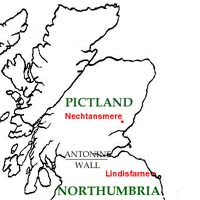May 20, 685: Battle of Nechtansmere: King Ecgfrith of Northumbria dies, fighting the Picts
 The Antonine Wall is a turf wall built by the Romans from the river Forth to the river Clyde across what is now Scotland in the second
century. While the Wall forms a convenient line on a map, it is not so easy to say where the border between the Anglo-Saxon Northumbrians and the Celtic Picts to the north actually lay.
The Antonine Wall is a turf wall built by the Romans from the river Forth to the river Clyde across what is now Scotland in the second
century. While the Wall forms a convenient line on a map, it is not so easy to say where the border between the Anglo-Saxon Northumbrians and the Celtic Picts to the north actually lay.
Events in the second half of the seventh century show that they did not agree themselves. Shortly after the death of King Oswiu of Northumbria (642-70) and the accession of his son Ecgfrith (670-85), the Picts rebelled against English rule. We do not know when the English conquered the Picts, but Oswiu conquered and held Anglo-Saxon Mercia in the later 650s, so perhaps he also conquered the Picts, and on his death they tried to win free.
The next known act in Northumbrian-Pictish affairs is Ecgfrith's raid in 685, recorded in Bede (HE iv.26). Ecgfrith took an army to ravage the kingdom of the Picts, apparently against the advice of his counsellors, including St Cuthbert. The Picts pretended to flee, lured Ecgfrith into some narrow passes in the mountains, and killed him and most of his troops at Nechtansmere (near modern Forfar). The Picts then succeeded in recovering their territory from the English, as they had failed to do in 670. However, the border skirmishes continued: there was another battle in 698, and several more in the eighth century.
Review the history, 642-774